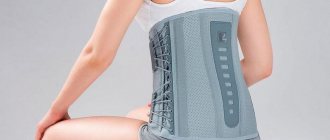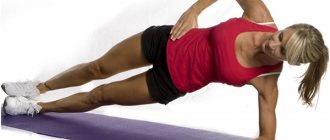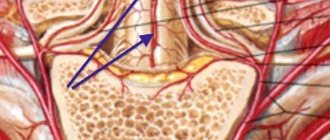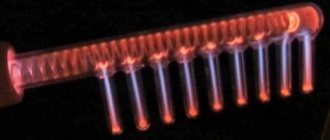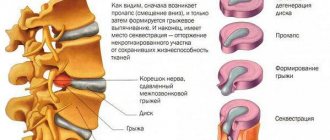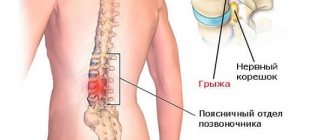Do you constantly or occasionally suffer from pain in the lower back, shoulders or neck? You can’t sleep anywhere—choosing the right mattress for a bad back is very important. Resting on an uncomfortable bed (or rather, on a place with an unsuitable mattress) can aggravate back problems and pain. If you are in an awkward position, the nerves and blood vessels are compressed. The brain reacts to this - it signals the muscles that the situation needs to be corrected. As a result, your body becomes tense throughout the night and you wake up completely unrested. Back pain intensifies, and tension in the muscle tissue is also added to it. Of course, we are not talking about any health.
For what back problems should you choose a “special” mattress?
A good orthopedic mattress for back pain is not a luxury. This is a necessity to improve the body's condition and speed up recovery. Or at least not make the problem worse.
We recommend that you carefully consider your choice, even if you are completely healthy and have never felt discomfort in the lower back or neck after sleep. It is easier to prevent any health problem than to treat it. A good mattress has a beneficial effect on all body systems, from endocrine to cardiovascular. Deep sleep, complete rest, you feel better and are ready for new achievements.
Organizing a sleeping area is important not only for older people whose bone structure changes and back pain becomes chronic. For the correct formation of the spine, children and teenagers need to choose a mattress. Young people also need a quality and comfortable place to relax
If you already have back problems, you need to be especially careful when choosing a mattress: the nature of the disease determines the characteristics of the sleeping place.
- Scoliosis in adults.
If you need high or medium rigidity, it is better to choose a springless model: this way, deformation of the spine during sleep will be minimized. Suitable fillers include natural or artificial latex or coconut coir. Orthopene may be overly soft - it is best to avoid it. - Radiculitis
To avoid additional stress on your back while you sleep, choose models of moderate rigidity with an independent spring block - only those segments on which the load is placed will be pressed, and you will lie flat. - Disc herniation.
The purpose of the mattress is to relieve muscles from hypertonicity and overstrain. A medium-hard model with independent springs and a latex layer is suitable. Memory foam is another option. - Rehabilitation after surgery.
Consult your doctor - a firm mattress with antibacterial filling will probably be right for you. For example, coconut coir. You should not skimp on your health: recovery requires caution. - Constant or recurrent pain of unspecified origin.
A high-quality double-sided model with independent springs, a layer of latex, coconut coir or memory foam will help you cope with them.
Remember: a mattress will help you cope with problems, but it will not replace medical care. If you have back problems, consult a doctor.
What else is important to consider when choosing a mattress?
Age
– perhaps the most significant factor. The older the person, the softer the sleeping place should be. In older people, bones become more fragile and joints undergo natural age-related changes. The pressure that a hard mattress creates can only cause harm and aggravate the pain.
In order for a mature man or woman to have a comfortable and deep sleep, and to have a complete rest, it is worth choosing medium and soft mattresses with a high degree of elasticity. Memory foam is fine. The material of the cover is also important: it should be natural, hypoallergenic, and pleasant to the body. To keep the product clean and for long-term use, buy a mattress cover.
On the left in the photo is a Hybrid mattress (independent springs + foam), the hardness is above average (for the younger generation). On the right is a springless Concept of medium elasticity (good for the older generation)
Weight
The “user” needs to be taken into account. Each mattress has a maximum permissible load - do not ignore this parameter. It is worth choosing “with a reserve”: if it is indicated that a person weighing up to 110 kg can sleep here, and you weigh 105-108, pay attention to models with an increased load - up to 120-130 kg.
Keep in mind that two people with different body weights will perceive the same mattress differently: a medium-firm model will seem very hard to a man weighing 60 kg, and rather soft to a man weighing 100 kg. If you are overweight, give preference to medium or high firmness options so that your body receives support during sleep and the sleeping place lasts as long as possible.
The photo shows a Blue Sleep Concept springless mattress with a load capacity of up to 120 kg.
Number of people
who sleep on a mattress. Double models must “take into account” the anatomical features of each spouse. If the difference in the weight of the partners is less than twenty-five kilograms, choose an option based on the maximum weight - for example, if the husband weighs 90 kg and the wife 76, a medium-hard mattress with a maximum load of up to 100 kg per bed is suitable. If the difference in body weight exceeds 25 kg, be sure to pay attention to products with independent spring blocks and combined stiffness. The comfort of both partners is an important condition for healthy and restful sleep.
Cons of hard mattresses
When you lie down on a hard bed, pressure points are created in the shoulders and pelvis (the heaviest parts of the body). They increase discomfort and provoke muscle tension. The body is uncomfortable, the spine suffers from compression - it is very difficult to find a comfortable position, problems with falling asleep and pain in the morning appear.
An overly hard mattress does not support the natural position of the spine. It forces your body to “arch”: you lie on a hard surface, supported only by your hips and shoulders. The body itself will try to compensate for the lack of support in the lumbar region, and this will only lead to severe pain.
There are gaps between the hard sleeping surface and your body - this is unacceptable. A good mattress adapts to the contours of the neck, shoulders, lower back, hips, provides maximum support, while the spine remains uncurved.
You shouldn’t look for something that is too soft either, because it creates a “hammock” effect: the spine arches, the pelvis is at the lowest point, the head is at the top, and your lower back, shoulders, and neck begin to ache.
To ensure comfortable sleep, it is important to ensure the anatomically natural position of the spine. "Massage" mattresses and models with rollers can help, but you shouldn't use them all the time. For daily sleep, you should choose a classic orthopedic model with high-quality filling.
What definitely won't work
Mattresses with a Bonnel spring block are unlikely to suit a person with a bad back. Dependent spring blocks bend under the heaviest part of the body - usually the hips - and form a dimple in the middle. The back takes on an unnatural position, the shoulders are too high, the pelvis is too low. As a result of sleeping on such a product, the pain intensifies, adding to it a feeling of overexertion in the back and shoulders.
A mattress for back pain can be either spring or springless, but in the first case only an independent block is suitable - when each spring is “dressed” in its own fabric pocket, all parts of the body are supported evenly.
The photo shows the Blue Sleep Hybrid Duo mattress with a double layer of more than 4,000 independent microsprings.
Symptoms of the disease
Only a doctor can make a diagnosis after examination. We advise you to go to the doctor and have your spine examined if you have the following symptoms:
- aching pain in the arms, legs, shoulders;
- decreased sensitivity in the limbs;
- insomnia, headaches, dizziness;
- bowel dysfunction.
There are a lot of reasons for the appearance of a hernia - improper sedentary lifestyle, injuries, heavy lifting, excess weight, even sleeping on a sagging old sofa.
Thin mattress for a sore back
If it is impossible to purchase a full-fledged orthopedic mattress right now, you should think about an intermediate option - for example, improving your sleeping area with a topper.
Topper – a thin mattress no less than 2, no more than 8 cm in height. It consists of a filler and a cover, and may contain several layers (for example, coir, latex, polyurethane foam). Smoothes out irregularities and creates an orthopedic effect.
You definitely need it if you have back problems, but you can’t buy an orthopedic mattress and a bed with a slatted base right now. The topper compensates for the excessive softness or hardness of your sleeping place and makes the surface smoother if you sleep on a mattress with a block of dependent springs or a sofa.
Pictured is the surface correcting topper Blue Sleep Cosmic
Product parameters
One of the main parameters when choosing a model is its size. The width, as a rule, is standard for all products: 80 or 140 cm, for a single or double bed, respectively. The length is selected according to the person’s height. The generally accepted standard for calculating the length of a product is: human height plus 22 - 25 cm. When purchasing, you must also take into account the weight. Modern manufacturers indicate the maximum allowable for a particular product.
Don't forget to take accurate measurements of your bed before purchasing. These parameters must coincide with the dimensions of the mattress, otherwise deformation cannot be avoided, and the anatomical effect will not be fully revealed.
Fillers - what are they?
- Technological memory foam is an artificial material that follows the contours of the body. When you rise from the mattress, the foam straightens out and it takes on its previous appearance. In the first days after purchase, the material may emit a not-so-pleasant chemical smell - the fact is that the product is stored in tight packaging until it is sold. This goes away after airing.
- Latex is an expensive but high-quality material that is produced from the sap of several varieties of rubber trees. It is elastic, dense, has an antibacterial effect, and is environmentally friendly. Does not press through, does not put pressure on the body. In addition, the material is breathable. A latex mattress will not be too cold or too hot. Natural latex is hypoallergenic.
- Coconut coir is a natural fiber from coconuts. Very hard, as a rule, pure coir mattresses are used only for small children. For adults, a layer of coir 1-2 cm high is enough to ensure rigidity. Material with antibacterial properties.
- Polyurethane foam is an artificial material with orthopedic properties. It has a porous structure and is most often foamed. It is from polyurethane foam that the basis of most orthopedic mattresses is made.
- Seaweed, sisal, horsehair are natural materials, soft, with antibacterial properties. Used as an additional layer.
Modern mattresses for problem backs rarely use one type of filler. More often they are combined, improving each other’s beneficial properties.
Lumbosacral radiculitis
Another disease that is much easier to prevent with preventive measures than to cure.
Several decades ago, it was a popular belief that sleeping on a hard surface was the best cure for back problems, including sciatica. Similar statements are still found in various reference books and articles. But nature itself, giving a curved shape to our spine, refutes such a statement. Prolonged, motionless stay on a hard, straight surface causes the spine to take the shape of a straight rod. In addition, a hard bed causes stagnation in blood circulation, pinching the vessels at the point of contact of the body with the surface of the bed. During such sleep, the body begins to go numb and a sensation of “pins and needles” arises.
The properties of modern orthopedic mattresses are such that they are able to adapt to the natural curves of our body and skeleton. And the choice here also needs to be made from models of medium hardness. And do not forget that with radiculitis it is very important to provide warmth to the diseased areas of the body. Pay attention to this when choosing a blanket. It is important that the blanket is not only warm, but also light. For a healthy person, an extra kilogram of load evenly distributed over the surface of his body is absolutely not important. But if you have back problems, you have to take this into account.
How and when to choose a mattress for a bad back
The best time to choose is in the evening, when you feel tired and back discomfort begins to bother you. If you buy a mattress online, be sure to make sure that you have enough time to test or the possibility of an exchange: even the best orthopedic models may not be suitable for you. If you buy in a regular store, lie down on the mattress, and not for a minute, but for several. Feel if you can relax. Turn from one side to the other, sit on your back or stomach. Check whether it bends under you, whether it is comfortable for your neck, shoulders, back, lower back, hips. A properly selected mattress should support all parts of the body.
Are you planning to change your pillow? Choose it together with a mattress. No? Then take it with you to the store to evaluate whether it will be convenient for you.
Features and rules of sleep with a hernia during pregnancy
The choice of position depends on what stage of pregnancy we are talking about. In the first trimester, you can use your usual orthopedic mattress and sleep in any position. However, in later stages, you should not sleep on your stomach to protect the fetus, and you should also avoid sleeping on your back to reduce the load on the internal organs. It is best to sleep on your left side, changing position several times a night. If severe pain occurs, you should carefully stand up and stretch.
